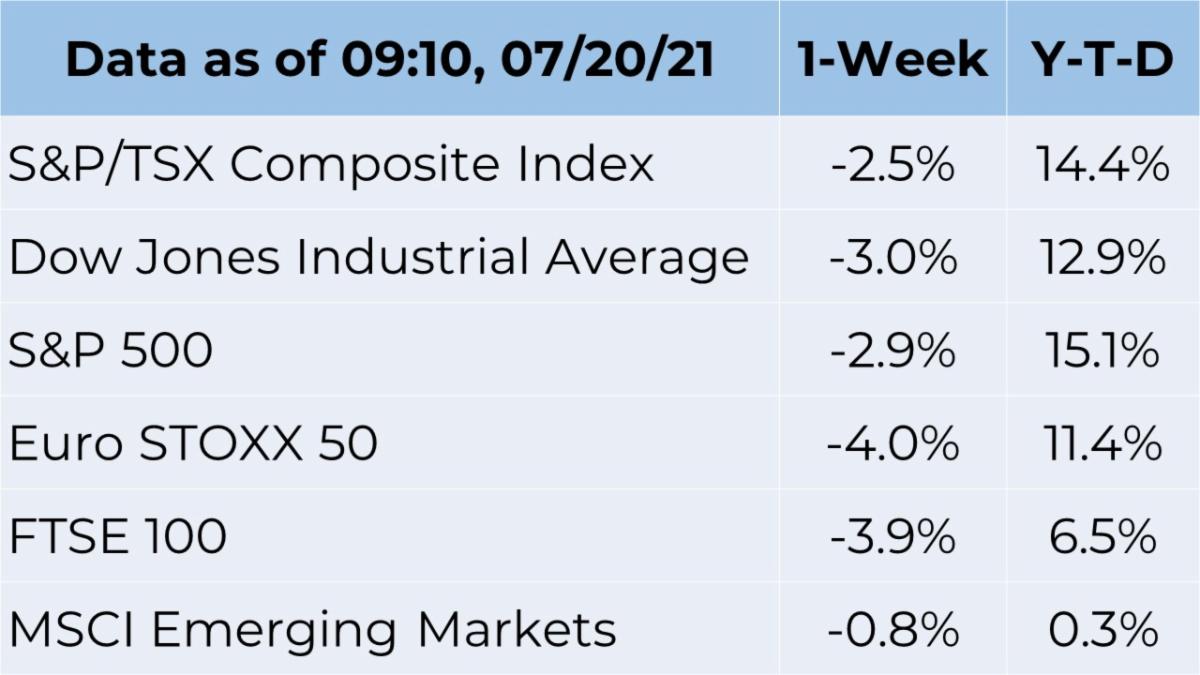Weekly Market Commentary - July 22nd, 2021
The Markets
“Peak growth” has become a common catchphrase, but it is a catchphrase with the potential to mislead. When the term is applied to the economy, it does not mean it has reached the pinnacle of growth and that it’s all downhill from here. It simply means economic growth is likely to continue at a slower pace than it had previously.
Last week, the bond markets appeared to signal slower economic growth ahead. Yields on 10-year U.S. Treasuries and 10-year Government of Canada bonds finished the week at 1.3 percent and 1.24 percent respectively, which was lower than the previous week and well below March highs.
The change in yields was surprising because of last week’s inflation report from the U.S. Bureau of Labor Statistics (BLS), which showed inflation well above the Federal Reserve’s target of 2 percent. The BLS reported inflation was 4.5 percent over the past 12 months when measured using the core Consumer Price Index (CPI), which excludes food and energy prices. With food and energy included, prices were up 5.4 percent. Canada has also experienced rising inflation, with Trading Economics reporting that the annualized inflation rate in May (the most recent data we have out of Canada) was the highest in over ten years.
When inflation rises above the central bank’s target, it suggests the economy is running too hot and, in the case of the U.S., the Federal Reserve typically raises the fed funds rate to cool things off. In this case, however, the Fed maintains that higher-than-desirable inflation will prove to be temporary. This position has been echoed by Tim Lane, Deputy Governor of the Bank of Canada.
The expectation that this inflation is transitory is due, in part, to supply chain shortages. The BLS report indicated inflation was up 0.9 percent in the month of June. Used car and truck prices rose 10.5 percent during the month, which accounted for more than one-third of the increase. A significant issue underlying the scarcity of vehicles is a microchip shortage.
“The origin of the shortage dates to early last year when the coronavirus caused rolling shutdowns of vehicle assembly plants. As the facilities closed, the wafer and chip suppliers diverted the parts to other sectors such as consumer electronics, which weren’t expected to be as hurt by stay-at-home orders,” reported Michael Wayland of CNBC. There are about 1,400 microchips in a new car or truck, according to CNBC, and it can take up to 26 weeks from order to delivery, according to Max Cherney of Barron’s.
While supply chain issues may be resolved with time, another aspect of inflation is wages. Over the last 12 months, wages have increased 6.1 percent, and in June, they were up 1.1 percent. That’s good news for workers, but it’s an aspect of inflation that’s unlikely to be temporary.
Major North American stock indices moved lower last week.

Source: Refinitiv
If you haven't replied to our survey already, could you please spare three minutes of your day, we would love to hear from you.
What are your hobbies and interests? Would you attend an event focused on such topic? Click below and let us know.

Weekly Focus - Think About It
“Whoever would overthrow the liberty of a nation must begin by subduing the freeness of speech.”
― Benjamin Franklin
Best regards,
Eric Muir
B.Comm. (Hons.), CIM®, FCSI
Portfolio Manager
Tracey McDonald
FCSI, DMS, CIM®
Portfolio Manager

